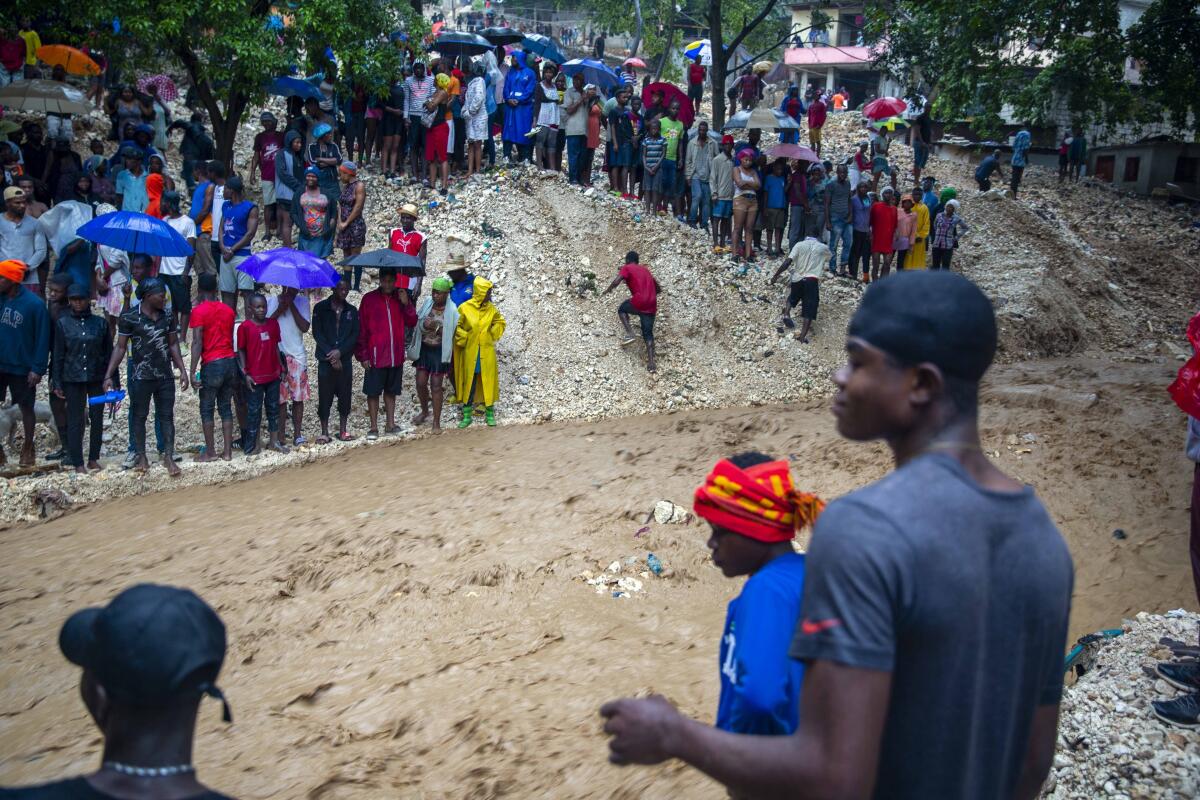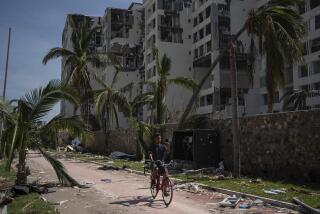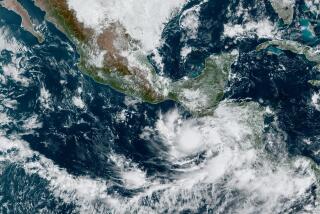Death and destruction in Haiti, Dominican Republic as Gulf Coast braces for tandem storms

At least nine people died in Haiti and two were missing on Sunday, when heavy rainfall from Tropical Storm Laura buried large swaths of the country under murky floodwaters and threatened to overpower its only hydroelectric dam.
Laura was headed for a possible strike later in the week on the Louisiana coast as a hurricane, along with a second storm, Hurricane Marco. The Gulf Coast braced Sunday for a potentially devastating hit from twin hurricanes as the two strong storms swirled toward the U.S. from the Gulf of Mexico and the Caribbean. Officials feared a history-making onslaught of life-threatening winds and flooding along the coast, stretching from Texas to Alabama.
Marco grew into a hurricane Sunday as it moved up the Gulf of Mexico toward Louisiana. Laura, after lashing the Dominican Republic and Haiti, appeared headed toward the same region of the U.S. coast.
The prospect of piggybacked hurricanes was reviving all-too-fresh memories of damage caused by Hurricane Katrina, which struck the Gulf Coast on Aug. 29, 2005. The storm has been blamed for as many as 1,800 deaths, and levee breaches in New Orleans led to catastrophic flooding.
“What we know is there’s going to be storm surge from Marco, we know that that water is not going to recede hardly at all before Laura hits, and so we’ve not seen this before and that’s why people need to be paying particular attention,” Louisiana Gov. John Bel Edwards said at a Sunday briefing.
If the storms do overlap, parts of Louisiana, especially in south-central portions of the state, could see rainfall of up to 2 feet, said Benjamin Schott, meteorologist in charge of the National Weather Service’s Slidell, La., office.
“There has never been anything we’ve seen like this before, where you can have possibly two hurricanes hitting within miles of each over a 48-hour period,” Schott said at a briefing.
In the Caribbean, “The waves are already spilling over” the seawall in the city of Gibara, Cuba, said Guillermina Montejo, a resident of the coastal Cuban city of Holguin. “Many residents have already left the area for fear of flooding.”
The center of Laura passed into Haiti Sunday morning after moving from Puerto Rico and through the Dominican Republic, where it also left at least four dead and a destructive trail of flooding, heavy rains and wind in its wake.
Among the dead: two children.
In Haiti, a 10-year-old girl in the southeastern town of Anse-a-Pitre near the Haiti-Dominican border was killed when a tree fell on her house. In the neighboring Dominican Republic, a 7-year-old died, along with a 44-year-old woman, when their house collapsed in Santo Domingo, the capital, which saw severe flooding and damaged homes.
Video posted on Twitter showed Dominican Civil Defense workers pulling trapped residents out of the rubble in at least one area of Santo Domingo known as Palmarejo.
“We want to show solidarity with the pain of these families; we ask God to bring them comfort and we ... will be there to help them with their needs,” Juan Manuel Mendez Garcia, the director of the Center of Emergency Operations, said in a news conference.
Laura left more than 1 million Dominicans without power, according to the country’s electric utility, and large parts of the Dominican Republic without water.
Mendez said the storm forced the evacuation of more than 1,050 Dominicans, damaged roads, knocked down trees and downed power lines while leaving large swaths of the country’s 11 million residents without services. Damages, he said, were concentrated in the northern and eastern regions of the country.
Although he did not say how many homes had been destroyed, Mendez said many houses were under the threat of being destroyed “because of what has happened to the rivers.”
In Haiti, Laura’s destruction was equally severe.
Officials spent the better half of an afternoon news conference Sunday pleading with Haitians to not cross rivers, and to protect themselves.
And as they pleaded with Haitians to stay put in some communities they also begged for some in others “to hurry and flee.”
An overflowing Peligre Dam in Haiti’s Central Plateau meant that authorities had to quickly release its waters, endangering the rice plains and farms in the nearby Artibonite Valley.
“All the radio stations that are here who can call the people of the Artibonite, tell them, ‘Attention!’ Secure their belongings because there is going to be a lot of water in the Artibonite Valley,” Public Works Minister Nader Joaseus said.
The dam is a key supplier of electricity and irrigation for the rice plains and farms north of Port-au-Prince. The probability of its destruction by the storm “was high,” Joaseus said. That would not only create a new crisis for the rural farmers of the Artibonite, who were already struggling with yields as Haiti undergoes a severe food shortage amid the COVID-19 pandemic, but “the little bit of electricity, the 10 megawatts that it gives us, we also won’t have it,”Joaseus said.
“If Peligre breaks, it will be catastrophic,” Agriculture Minister Patrick Severe added, while begging for Haitians cooperate. “We can diminish the effects of flooding but we can’t eliminate it.”
With all of their disaster-prone country under siege by Laura, Haitians experienced flash floods in the southeast, wind gusts of 50 mph in the north and severe flooding throughout, including in the capital, where some were forced to wade through waist-high dirty water.
Even Port-au-Prince’s Toussaint Louverture International Airport was not spared floodwaters.
Overnight, Haiti had raised its severe weather alert from orange to red, the country’s highest.
Prime Minister Joseph Jouthe, offering his and the president’s condolences over the loss of life and property, said earlier in the day: “Five people are already dead, and it’s five too many.”
The Miami Herald and El Nuevo Herald contributed to this report.
More to Read
Start your day right
Sign up for Essential California for news, features and recommendations from the L.A. Times and beyond in your inbox six days a week.
You may occasionally receive promotional content from the Los Angeles Times.






